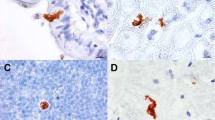Summary
Ten different mouse cell lines were examined for Japanese encephalitis virus (JEV) infection in vitro and then tested for their ability to generate virus specific cytotoxic T lymphocytes (CTL). Among all cell lines examined, Neuro 2a (a neuroblastoma) was readily infected with JEV as examined by immunofluorescence and viral replication. Among other cells, P388D1, RAW 264.7 (Macrophage origin), Sp2/0 (B-cell Hybridoma), YAC-1 (T-cell lymphoma), and L929 (Fibroblast) were semipermissive to JEV infection. The cytopathic effects caused by progressive JEV infection varied from cell line to cell line. In the case of YAC-1 cells long-term viral antigen expression was observed without significant alterations in cell viability. Intermediate degrees of cytopathicity are seen in RAW 264.7 and L929 cells while infection of PS, Neuro 2a, P388D1 and Sp2/0 caused major viability losses. All infected cell lines were able to prime adult BALB/c (H-2d) mice for the generation of secondary JEV specific CTL. In contrast to YAC-1, the permissive neuroblastoma cell line Neuro 2a (H-2KkDd) was found to be least efficient in its ability to stimulate anti-viral CTL generation. Cold target competition studies demonstrated that both Neuro 2a and YAC-1 (H-2KkDd) cells expressed similar viral determinants that are recognised by CTL, suggesting that the reason for the lower ability of Neuro 2a to stimulate anti-viral CTL was not due to lack of viral CTL determinants. These findings demonstrate that a variety of mouse cell lines can be infected with Japanese encephalitis virus, and that these infected cells could be utilised to generate virus specific CTL in BALB/c mice.
Similar content being viewed by others
References
Engelhard VH (1994) Structure of peptides associated with MHC class I molecules. Curr Opin Immunol 6: 13–23
Gould EA, Clegg JCS (1985) Growth titration and purification of alphaviruses and flaviviruses. In: Mahy BWJ (ed) Virology, a practical approach. IRL Press, Oxford, pp 43–74
Gomard E, Levy JP, Plata F, Henin Y, Duprez V, Bismuth A, Reme T (1978) Studies on the nature of the cell surface antigen reacting with cytolytic T lymphocytes in murine oncornavirus-induced tumors. Eur J Immunol 8: 228–236
Hase T, Summers PL, Eckels KH, Baxe WB (1987) Maturation process of Japanese encephalitis virus in cultured mosquito cells in vitro and mouse brain cells in vivo. Arch Virol 96: 135–151
Hase T, Summers PL, Eckels KH, Putnak JR (1989) Morphogenesis of flaviviruses. In: Harris JR (ed) Subcellular biochemistry. Plenum Press, New York, 275–305
Hase T, Summers PL, Ray P (1990) Entry and replication of Japanese encephalitis virus in cultured neurogenic cells. J Virol Methods 30: 205–214
Hase T, Summers PL, Ray P, Asofo-Adjei E (1992) Cytopathology of PC12 cells infected with Japanese encephalitis virus. Virchows Arch B Cell Pathol 63: 25–36
Hasegawa H, Satake Y, Kobayashi Y (1990) Effect of cytokines on Japanese encephalitis virus production by human monocytes. Microbiol Immunol 34: 459–466
Hill AB, Mullbacher A, Parrish C, Coia G, Westaway EG, Blanden RV (1992) Broad cross reactivity with fine specificity in the cytotoxic T cell response to flaviviruses. J Gen Virol 73: 1115–1123
Kedarnath N, Dayaraj C, Sathe PS, Gadkari DA, Dandavate CN, Goverdhen MK, Ghosh SN (1986) Monoclonal antibodies against Japanese encephalitis virus. Ind J Med Res 84: 125–133
Kedernath N, Gore MM, Dayaraj C, Sathe PS, Ghosh SN (1986) Effect of mitogens on the replication of Japanese encephalitis virus in human mononuclear leukocyte cultures. Ind J Med Res 84: 231–238
Kelkar SD, Banerjee K (1977) Mononuclear cells in Japanese encephalitis virus infection: changes in cell counts and specific fluorescence. Acta Virol 21: 417–421
Khanna N, Agnihotri M, Mathur A, Chaturvedi UC (1991) Neutrophil chemotactic factor produced by Japanese encephalitis virus stimulated macrophages. Clin Exp Immunol 86: 299–303
Kimura-Kuroda J, Yasui K (1988) Protection of mice against Japanese encephalitis virus by passive administration with monoclonal antibodies. J Immunol 141: 3606–3610
Konishi E, Pincus S, Paoletti E, Shope RE, Burrage T, Mason PW (1992) Mice immunised with a subviral particle containing the Japanese encephalitis prM/M and E protein are protected from lethal JEV infection. Virology 188: 714–720
Mathur A, Kulshrestha R, Rawat S, Chaturvedi UC (1987) Memory supressor T cells in latent Japanese encephalitis virus infection. Immunology 60: 71–74
Miura K, Onodera T, Nishida A, Goto N, Fuzisaki Y (1990) A single gene controls resistance to Japanese encephalitis virus. Arch Virol 112: 261–270
Monath TP (1986) Pathobiology of flaviviruses. In: Schlesinger S, Schlesinger MJ (eds) The togaviridae. Plenum Press, New York, pp 375–440
Mullbacher A, Ashman RB, Ada GL (1984) Alloreactive cytotoxic T lymphocytes lyse syngeneic influenza infected tumour cell targets. Scand J Immunol 19: 365–371
Murali-Krishna K, Ravi V, Manjunath R (1994) Cytotoxic T lymphocytes raised against Japanese encephalitis virus: effector cell phenotype, target specificity and in vitro virus clearance. J Gen Virol 75: 799–807
Ota E (1965) Electron microscopic study of the development of Japanese encephalitis virus in porcine kidney stable (PS) cells. Virology 25: 372–378
Rehazek J (1968) Persistent infection of mosquito cells grown in vitro with Japanese encephalitis virus. J Virol 31: 816–822
Rosen L (1986) The natural history of Japanese encephalitis virus. Annu Rev Microbiol 40: 395–411
Udaka K, Tsomides TJ, Eisen HN (1992) A naturally occurring peptide recognised by alloreactive CD8+ cytotoxic T lymphocytes in association with a class I MHC protein. Cell 69: 989–998
Umenai T, Krzysko R, Bektimirov TA, Assad FA (1985) Japanese encephalitis virus: current worldwide status. Bull World Health Organ 63: 625–631
Westaway EG (1980) Replication of flaviviruses: In: The togaviruses. Academic Press, New York, pp 531–577
Westaway EG, Brinton MA, Gaidamovich SY, Horzinek MC, Igarashi A, Kaariainen L, Lvov DK, Porterfield JS, Russel PK, Trent DW (1985) Flaviviridae. Intervirology 24: 183–192
Author information
Authors and Affiliations
Rights and permissions
About this article
Cite this article
Murali-Krishna, K., Ravi, V. & Manjunath, R. Japanese encephalitis virus infection of mouse cell lines: ability to prime mice for generation of virus specific cytotoxic T lymphocytes and differences in CTL recognisable viral determinants. Archives of Virology 140, 127–143 (1995). https://doi.org/10.1007/BF01309728
Received:
Accepted:
Issue Date:
DOI: https://doi.org/10.1007/BF01309728




